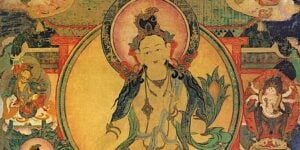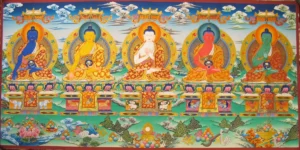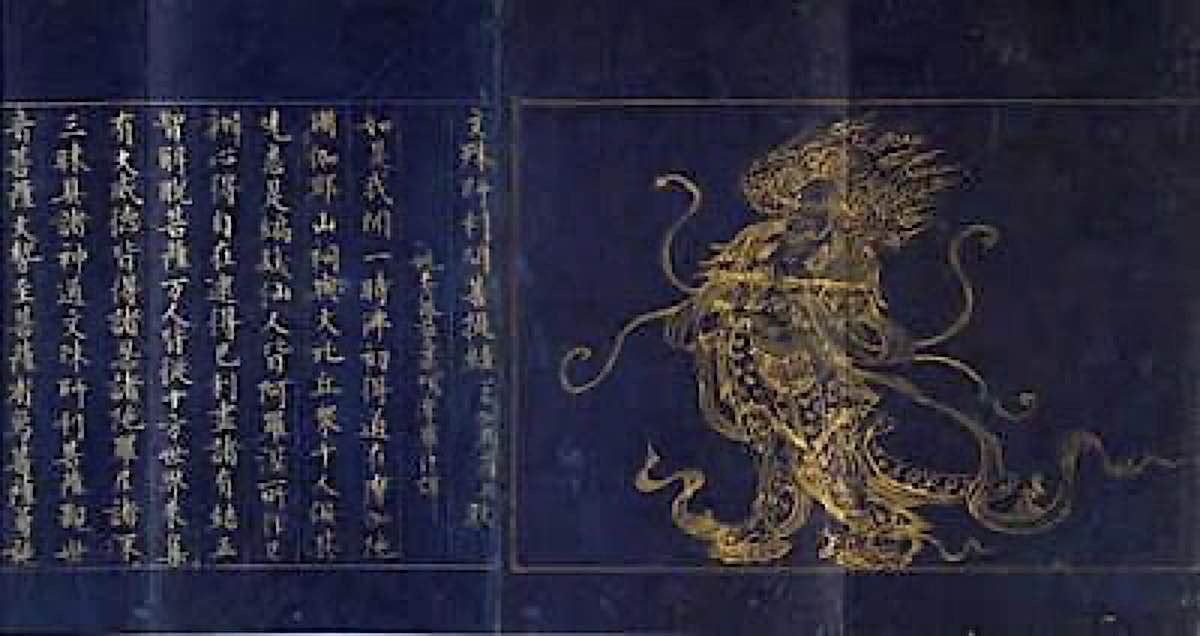Transforming all ten poisons with the skillful psychology of Buddhist Vajrayana — the creative approach to practice
The symbolism of Vajrayana spans every facet of life — and imagination — from the mundane, to love-making, to demon-slaying, to wrathful conquering. Every aspect of practice is expressed in visualization — in the vast expanse of imagination — rather than as two-dimensional words on a page. The element of the practice is to involve all of the senses in the process of transformation. Tantric practices are Yogas — which literally translates as “join.” The joining here, is Compassion and Wisdom, Bless and Emptiness. The other joining, or connection — often represented in Vajrayana as the consorts, Buddha and consort — is “skillful means” and the “ultimate wisdom”. The skillful means refers to creativity, art, visualization, imagination, psychology — all with the ultimate goal of understanding the true nature of reality — or Enlightenment. This is expressed in its ultimate form in thangka art and Dharma statues, which convey universal symbols and messages.
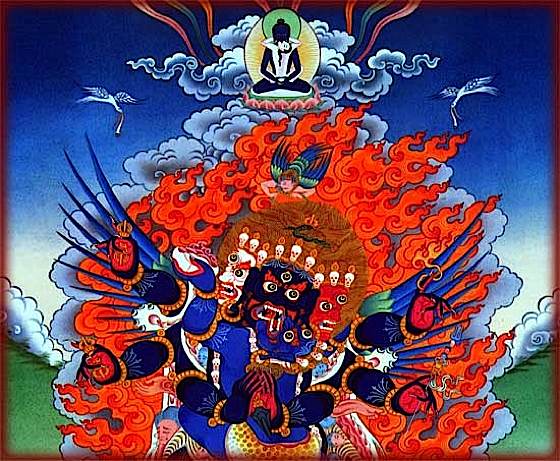
The Psychology of Tantra — It brings practice into everyday living
Psychologist Rob Preece describes the benefits and uniqueness of Tantric methods:
“Tantra is the unfolding of a creative process, which occurs moment by moment in the act of manifestation and transformation. In this sense, we continually experience the process of creative transformation in every aspect of our lives.
When the process unfolds naturally, as an expression of our true nature, we experience a flow of vitality in all we do. But when this process becomes stuck or blocked, we experience varying degrees of dis-ease and suffering… Each of us has the innate potential to awaken fully, and to give individual expression to our true nature in our lives. This potential is the seed of our Buddha nature, which, once awakened and allowed to manifest, can creatively enrich our lives. [9]
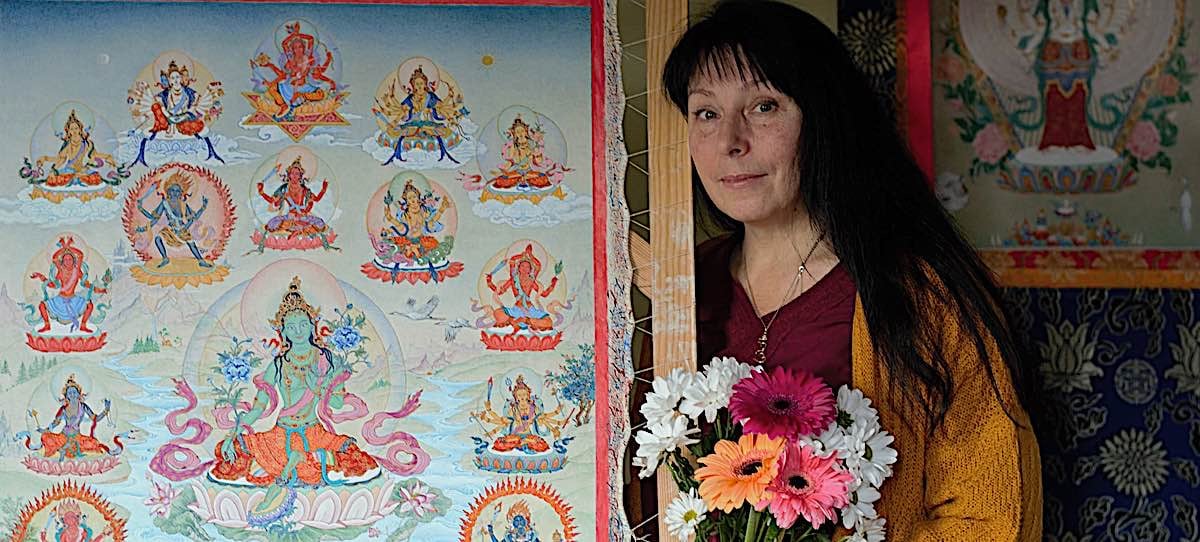
Tantra is creative and transformative
Tantra, then, is both a creative art and experience — we develop our imaginations, and “role play” almost like actors — but also a transformative, psychologically-grounded method. (If properly guided by a teacher.) But, before getting into what Tantra is, it’s important to wrestle with this incorrect persona of “Tantra” as “sexual.” Where sex is involved, it’s in the context of either symbolism, or tranformative process of an ordinary samsaric craving.
It’s important to separate the metaphor from the literal — a perspective issue in Western thinking according to Robin Kornman:
“The problem Westerners have in reading Buddhist tantra is that they cannot tell allegory from literal speech. In the nineteenth century, the West discovered the existence of Hindu and Buddhist tantra—paths that like Western alchemy emphasize transmutation of the ordinary into the spiritual. Tantric iconography includes representations of fornicating deities, usually with multiple heads and limbs (although strangely enough, their sexual organs are always true to life), and it was perhaps for this reason that Western scholars thought tantra had something to do with sex.”
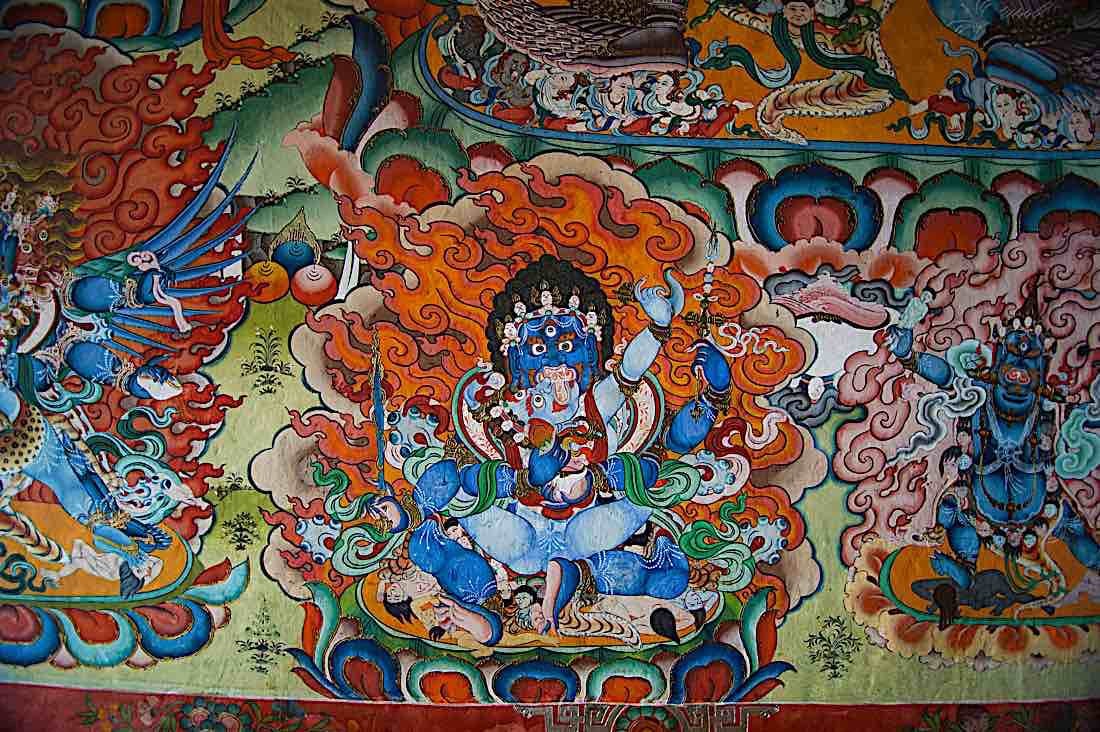
Tantra is about transformation, rather than suppression
Tantric methods are about “transformation” rather than subjugation of those very things that trap us in Samsaric suffering. Joy, bliss, anger, greed, fear, and sex can all become attachments, even addictions. [Aha! There is sex!] Suppressing our cravings doesn’t work for everyone — which tends to be where Tantra steps in. By recognizing Samsara and Nirvana are inseparable, we find we can transform the negative emotions. It is this aspect of transformation, versus suppression, that has led many psycho-therapists to study and use some tantric methods.
The great Lama Yeshe described Tantra this way:
“The same desirous energy that ordinarily propels us from one unsatisfactory situation is transmuted, through the alchemy of tantra, into a transcendental experience of bliss and wisdom. The practioner focuses the penetrating brilliance of this blissful wisdom so that it cuts like a laser beam through all false projections of this and that and pierces the very heart of reality.” [8]
Again, quoting from Robin Kornman’s excellent article:
“Of course, one can make a big deal out of sex by giving it special attention. There are special tantric yogas which can transmute the mundane act of fornication into a meditation practice, but of course, everything can be transmuted that way. There are contemplative approaches to eating, to walking, to calligraphy, to, in fact, everything. There is a yogic way of taking a nap and a yogic way of decorating a room. Anything can be turned into a yogic exercise if it is given special attention. Dogen Zenji’s Shobogenzo even lays down regulations for dental hygiene.”
Renunciation and Transformation
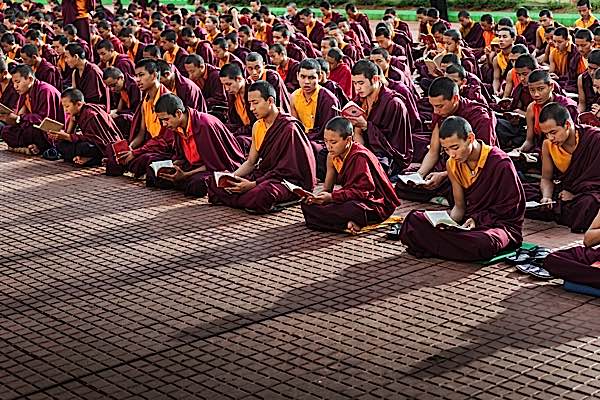
Buddhist monks renounce sex — but they also renounce all ordinary activities. It’s not about sex, it’s about attachments, including food, money, power, fashionable clothes. They might eat one meal a day, given to them by lay people, following the example of the Bikkhus. However, it is important to understand that in Buddhism, sex is not seen as evil, but, simply as a normal craving to be overcome with discipline, concentration and meditation. Or, in the case of Tantra, with transormative meditation.
The Lay (non-monastic) Tantric Buddhist embraces ordinary activities as the path. Instead of “overcoming” cravings for pleasure, or trying to calm our anger, Tantra transforms them. The classic Tantra example is transforming Anger into the energy to practice. In a wonderful teaching “Wheel of Sharp Weapons” by Gelek Rimpoche, her explained:
“Mother beings and innocent beings are not fit to be the object of hatred or anger at all. On the other hand, negative emotions that are creating suffering, in particular the imposter ego, is fit to be the object of your hatred or anger.”

In other words, we transform our fury and hatred towards an object that can virtuously benefit from that directed power — in this case our own ego. Rimpoche adds, “When you use your hatred, etc. on the right object, the recognized enemy, even though you will not get rid of anger and hatred completely, doing that is transforming anger-hatred into the path. Using anger-hatred on the negativities is using anger-hatred as the path, while using it against living beings is negativity.”
Tantra everyday examples of transformation
Tantra practice is not really about the one hour in front of your shrine at night, generating Bodhichitta with your Yidam’s Sadhana. It is about carrying the Buddha Dharma into every moment of every day life. This is why in Higher Yogic Practices we have Yogas that take us through the entire 24-hour cycle of daily Samsara:
- Sleeping Yoga [For a related story on Dreaming Yoga, see>>]
- Rising or Awakening Yoga
- Tasting Nectar Yoga (When eating a meal)
- Generating as Yidam and other practices
- Everyday Activities as Yoga: where we try to subtly visualize ourselves as Enlightened Deities throughout the day, as the Tantric texts say: “All sounds are Mantras, all beings are Buddhas…”
Certainly, we aren’t really manifesting as a six-armed Hayagriva througout the day, except in our own mindstreams. Yet, that awareness — in the same way as mindfulness (only, perhaps, more actively) keeps us aware of our Buddha Nature in those times when we need to transform a craving or anger or hate.
What do we mean? Everyday life examples — which is where we practice actually Tantra — might be:
- An angry “boss” at work might redirect his anger, remembering his meditations on Yamantaka (representing the transformation of anger) — and feel his anger transform into energy to meet the deadline. He will not to vent on his team members, but rather turn that furious energy into the power to make the deadline.
- A lazy person might meditate on the wrathful energy of Hayagriva to inspire renewed motivation. He might turn his anger on himself — incinerating the laziness with the flames of enthusiasm to practice.
- A person having lustful thoughts and considering an affair might transform these dangerous cravings with Vajrayogini practices. The Yogas of Vajrayogini are particularly effective in daily life.
- A fearful person, incapacitated by fears, can find strength in Tara and Prajnaparamita — and the solice of Emptiness.
These are skilled practices, taking years of training and guidance by a teacher, but they are very effective.
Tantra: “Every ride in the amusement park”

It is the non-duality of Samsara and Nirvana that empowers Tantra and Zen both — in different ways. Sasha Manu explains: “the journey of a Tantrika is a transformative process of experiencing the realm of duality in its fullest, and then transcending it. Whereas the Zen journey immediately attacks the misconceptions of Samsara and aims to quickly transcend all forms of dualistic thinking. Zen is taught from the perspective of Nirvana, teachings are predicated on Buddhahood being inherent within us. While Tantra is taught from within Samsara, with mastery of the phenomenal world leading to transcendence of it. This leads to the Tantric path being gradual and immersive, while Zen is simple and direct.” [6]
He also uses a humorous anecdote:
“A Zen pupil walks directly from the entrance of an amusement park to the exit, while the Tantrika goes on every ride before exiting.”
The problem is, not everyone can absorb the full experience by going directly to the exit — which is where Tantra excels. For those of us drowning in an ocean of passions and sensory thrills, Tantra can be the path that transforms the “thrill rides” into Wisdom.
The Tantric enhancement: Unity of Samsara and Nirvana
The best “concise” description, explaining the difference between Tantra and Mahayana generally — seems to be from an introduction to scholar Edward Conze’s Buddhist Texts Through the Ages explaining that
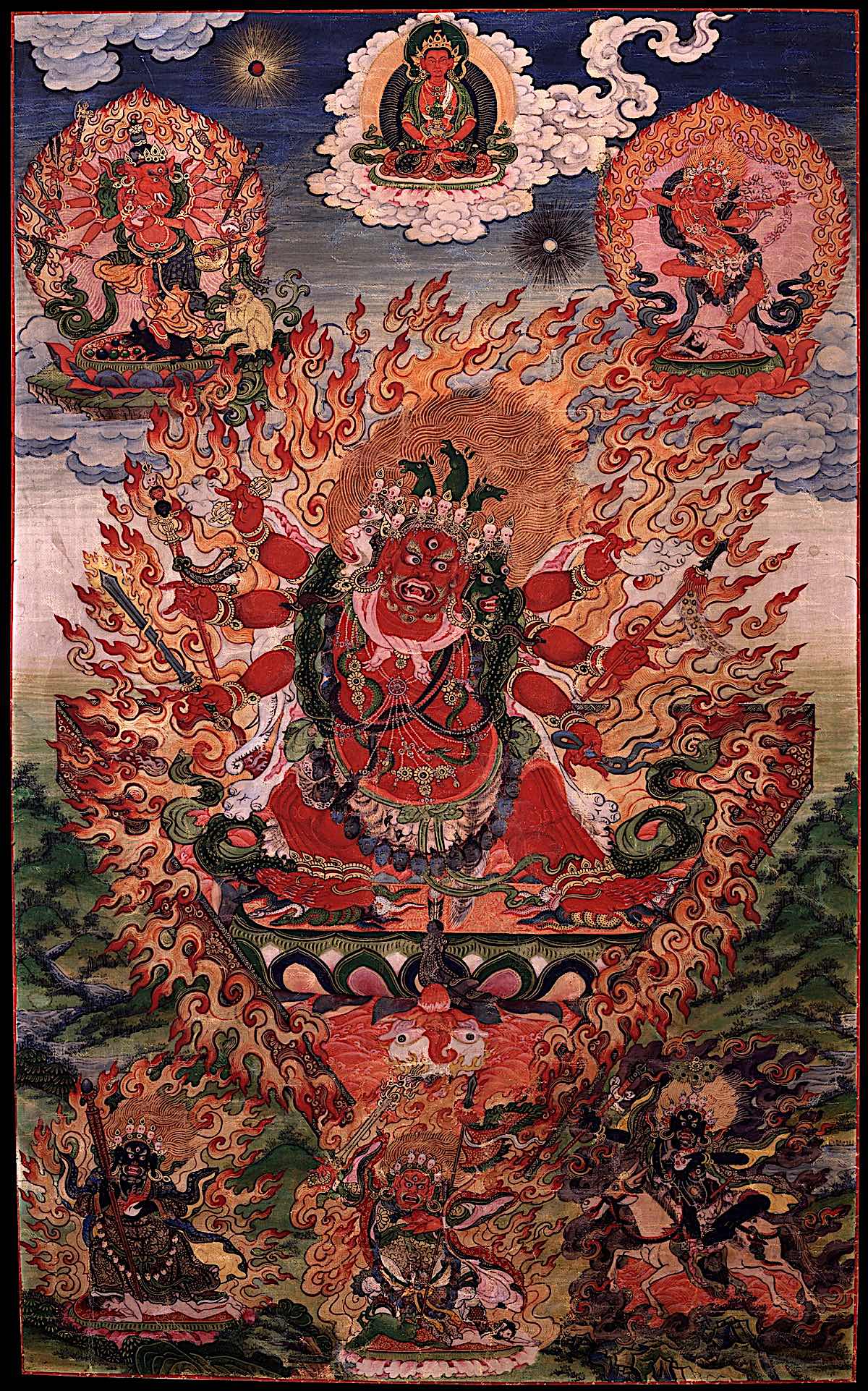
Tantrists hold “their conviction that the truth was but a matter of inner realization, and that this was not to be found by fleeing from a world of which man is essentially part, but by comprehending it in its true condition and by continuing to live in it. This is what is meant [in the Tantras] by the unity of Samsara and Nirvana, which was for them the limit of perfection.” [5]
This is also expressed in the tantric expressions of “unity of Wisdom and Compassion” — as symbolized in the ultimate Tantric symbols of Bell and Dorje (Ghanta and Vajra). Unity and matrix is a core aspect of the meaning of Tantra (and the bell / Dorje):
- Unity of Nirvana and Samsara
- Indivisible Emptiness and Form
- The inseparability of Wisdom and Compassion
- Wisdom and Means joined
- Six perfections of Wisdom (bell) and the five perfections of Means (five-spoked Dorje: generosity, morality, patience, perseverance, concentration.
- For more on the Bell and Dorje symbolism, see this full feature>>
The entire tapestry of life in Buddhist Tantra: analogous to martial arts
A key element of Buddhist Tantra is practice. Another key element is the Guru. In this way, Tantra is directly analogous to martial arts: to excel in martial arts requires a teacher of known lineage and skills; and endless practice. In Tantra, the Guru is central, certainly, since to walk the path we must understand the path. Then, begins the long journey. One eminent teacher of Vajrayana, H.E. Zasep Rinpoche, joked about the endless practice and repetition in Vajrayana: “The Buddhas must be deaf.”
- Clearly, then, practice in our daily lives is Tantra, especially:
- Visualizing ourselves as Enlightened in our daily lives as a practice
- Chanting mantras as verbal real-life practice
- Daily “dissolving” of self into emptiness, and building back up into the mandala (Generation practice)
Over time, we begin to understand that Samsara and Nirvana are one, that what we are seeking is not separated from our daily lives. This also leads to an understanding, as explained by Venerable Khenchen Thrangu Rinpoche that
Vajrayana is “an advanced skilful method that enables practitioners to become free of clinging to false notions and beliefs regarding inherent existence of appearances and experiences and therefore of an individual self.”
Tantra is esoteric rather than exotic: and very upliftingly positive
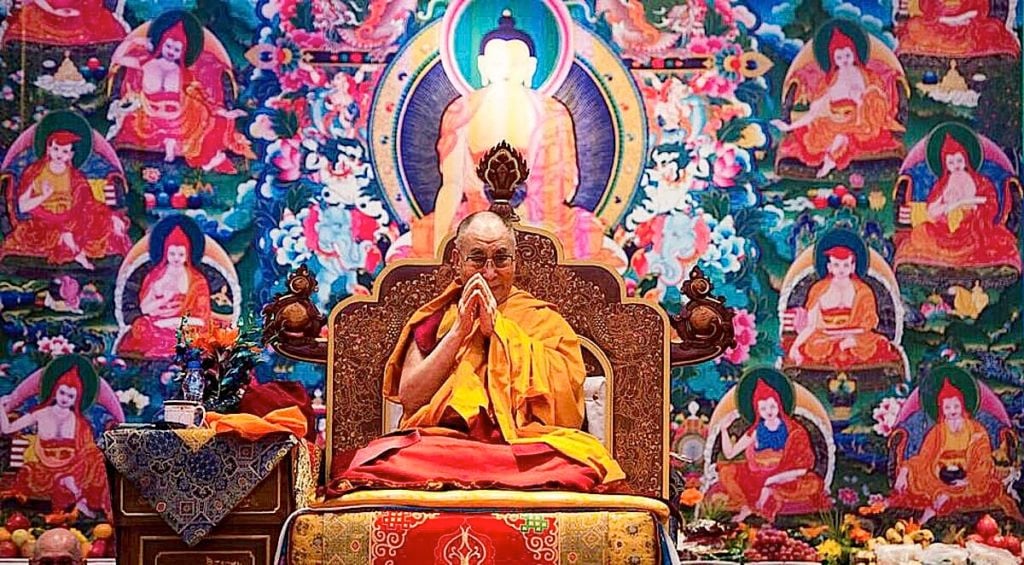
Tantra requires a teacher to avoid misunderstandings, but it is above all irresistibly blissful and wondrous. Instead of seeing Emptiness — not to be confused with Nihilism — through the lens of intellect or stillness, in Tantra see through the lens of “Expansiveness” and “Bliss — and, the participant is very engaged and active. Instead of trying to “empty our mind” or trying to remain permanently “mindful” we engage the mind in visualization. Today, sports coaches, psychotherapists and business leaders use visualization techniques, in much the same way as Tantra — except they visualize mundane aspirations.
Although Tantric Buddhists do engage in traditional Samatha and Vipassana meditation, the key point of difference in Tantra is the aspirational visualization guided by a teacher, incorporating the motivational power of “bliss.”
Unlike the sports coach, who teaches us to visualize the end goal of winning, in Tantra, we visualize ourselves as we would like to be — as future Buddhas. For these reasons, Tantra is irrepressibly cheerful in outlook because we undertake blissful visualizations. We see ourselves in a state of happy realization; no, we’re not there, yet, but we never stop trying. It’s like a dress-rehearsal for Enlightenment. Instead of analyzing concepts such as Emptiness, Bliss, Clear Light, or trying to achieve realizations through one-pointed focus or mindfulness, Tantrics engage in visualization and well-established rituals, dress-rehearsals of a script, based on methods established by a long-lineage of accomplished teachers.
Real life and Buddha Nature — Tantra embraces both
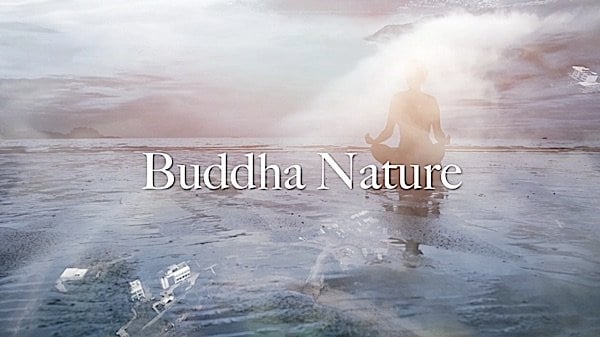
Key to Tantra, as with Mahayana, is the concept that all beings, from ants to humans, have Buddha Nature. This directly relates to the idea of Samsara and Nirvana as one. You don’t look for enlightenment in denial — but in understanding the true nature of reality.
Although sex is a part of living and Samsara — and therefore appears in Tantra — for example in the concept of consorts representing, again, wisdom and means — it is not what Tantra is about. It’s part of what life is about, certainly, and therefore also a part of Tantra. Which brings us back to that sensationalist, Pierre Bernard.
Sensationalist Bernard misrepresented Tantra
Although the sensationalist Pierre Bernard (1875-1955) is credited with popularizing non-Buddhist Tantra in North America, he is also the main reason it is erroneously associated with sex, and other misunderstandings. He was notorious, charged with kidnapping teenage girls, and making sex a focus of his version of tantra. [More on him later, if you’re curious.]
Removing the sex from Tantra?
If removing the sex from Tantra makes it less alluring, it shouldn’t, since Tantra includes “all the rides,” including sex, and weaves “copious” methods designed to lead to “Liberation.” [The word Tan-Tra means Copious (Tan) and Liberation (Tra.) ] And, as explained, these “copious” methods embrace all of Samsara and Nirvana. The aim is transformation. A skilled practitioner can transform sexual attachments, addiction to joy, afflictions of anger, or any other attachment with Tantra.
Yes, there are sexual images in Buddhist thangkas. Again, quoting Robin Kornman:
“The sexual thangkas are just as allegorical as the thangkas that show wrathful deities sacrificing live animals and eating human flesh. If these things were even 1% literal, Buddhism would be a religion of enraged, horny maniacs.”
Tantra are ancient methods — not a single spiritual path limited to the Vedas, Hinduism or Buddhism — and while it may be exotic, it has nothing to do with sexual positions. It’s also not a “religion” or specific spiritual path, but rather a collection of methods — revolving around visualization, mantras and guru training and initiation. Tantra predates Buddha, going back to the Vedic era texts, including the Atharvaveda and Brahmanas. [1] The legendary root of it all was Shiva, the Adiyogi (not referring here to the god), the “first yogi” from 15,000 years ago. [2]
In Buddhism, Tantra is normally associated with the more advanced practices of Vajrayana or Zen. (Not all Vajrayana Buddhists or Zen Buddhists practice Tantra, any more than all Buddhist practice one form of meditation, such as Samatha.) Again, they are a collection of methods, taught by Guru, and normally including visualization and mantra, and a transformation of desires or emotions.
These practices trace through the ancient Mimamsa; later, broader Hinduism, Vajrayana and Zen Buddhism (both), and Daoism. Bernard, unfortunately, made it a “new age” sex thing, trivializing an important spiritual method.
Buddhist and Hindu Tantra
In legend, the great Lord Shiva “does not give any philosophical explanations, but instead gives very direct instructions on the methods to liberation. Siva Sutras and Vighyana Bhairava Tantra are popular texts that contain specific techniques to liberate the embodied soul from the limitations of the body and mind and experience his true blissful nature.” [2] Likewise, in Tantric Buddhism, the methods are pointed out by a Guru, explored by the individual Yogi, and focus on experiencing the “clear light of bliss.” Bliss is a central focus of Tantra — together with “direct pointing out by a Guru” — and herein may have been the initial confusion of Bernard. Sex, and bliss are not the same thing.
Why are Buddhist and Hindu Tantras similar? Even the visualizations and deities imagined — at first — seem similar. Of course, Buddhism developed from ancient Vedic philosophies. The words Dharma, Karma, Yoga, Tantra, Metta, Bodhichitta — these all pre-date Buddhism. Buddhism has a special focus, the goal of Enlightenment as taught by Shakyamuni Buddha, but it has roots in ancient Vedic religion. The methods may be similar, although the end goal is different. It should not surprise anyone that “seated meditation” and “Tantra” — often associated with Buddhism — are methods that pre-date the Buddha.
Then, what is Tantra?
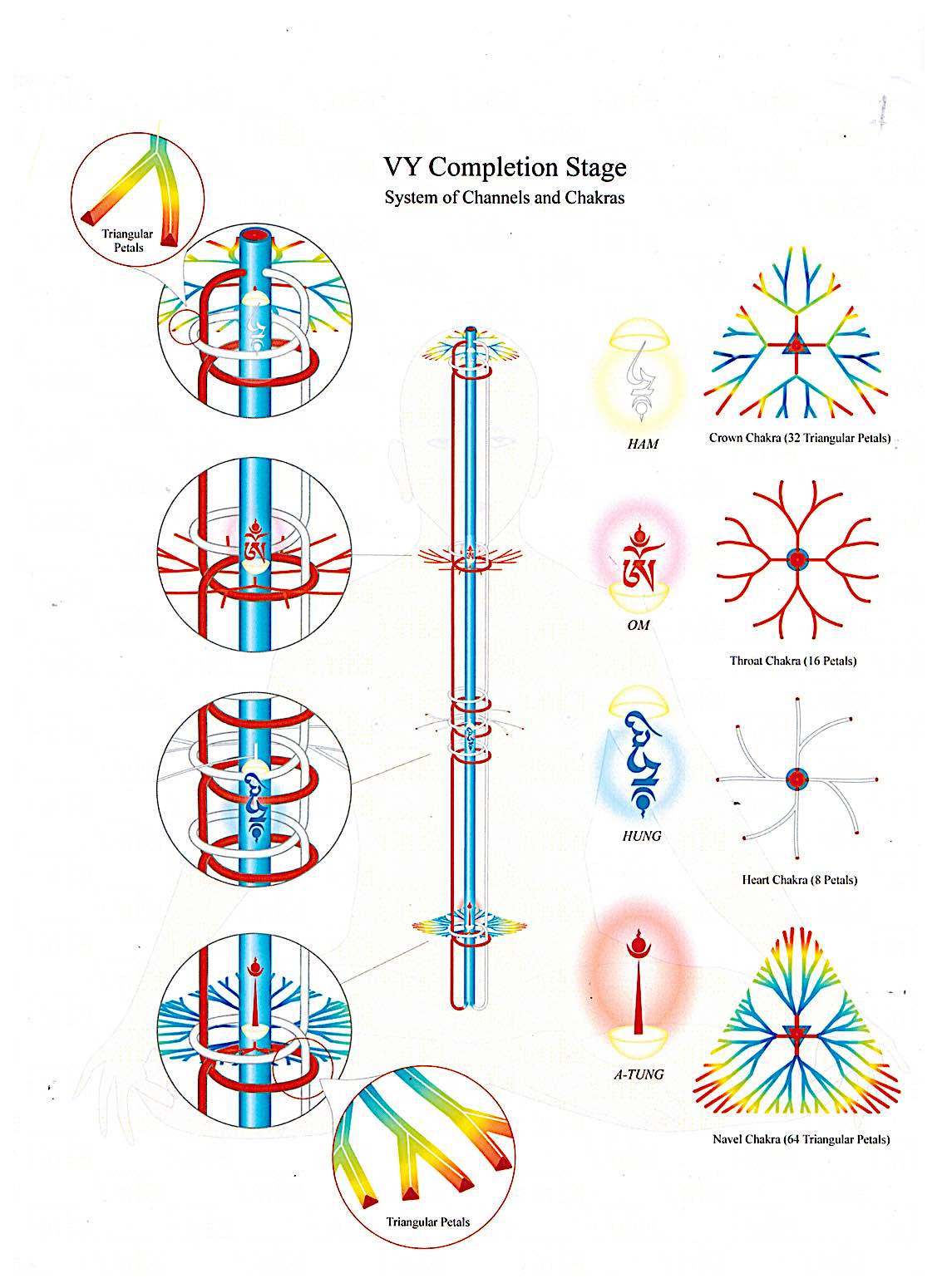
Just as it is nearly impossible to properly define Zen, Tantra proves just as elusive. The English translation of the two syllables “Tan-Tra” is most commonly given as “Copious” (Tan) and Liberation (Tra.) It is certainly associated with understanding the true nature of reality (Tattva). Another definition of Tantra, a literal translation, can be “loom, warp, weave.” [1] This can refer to the “weaving” of different teachings and traditions together as a practice.
It could be said, that meditation is practiced by all spiritual paths in one way or another. Likewise, there are Tantric practices in many spiritual paths. The methods are similar, the destination is different.
Vajrayana Buddhism teaches, among other methods, Tantric methods, with that important goal of “Purifying one’s impure perception of all appearances and experiences,” according to His Eminence Jamgon Kongtrul Rinpoche the Third. Zen Buddhism also incorporates many Tantric methods.
The Omnipotent Oom — Bernard a.k.a. Perry Baker
Terms such as “Tantrism” — just like the misleading term “Lamaism” — are Western inventions of early scholars who did not understand the profound Tantras. Likewise, the association with “sex” is the invention or exaggeration of a controversial early American non-Buddhist “Yogi” who named himself Pierre Bernard (born Perry Baker, or Peter Coon, he kept his history secret) who dabbled in occultism, mysticism, business, and called himself “Oom the Magnificent” — sometimes “The Omnipotent Oom.” His teacher was Sylvais Hamati, who taught him hatha yoga. Bernard, the sensationalist, became famous when he invited surgeons to push needles through is cheek, lip and nostril, apparently without feeling pain. At one point he was charged in 1910, with kidnapping two teenage girls, Zella Hoppa and Gertrude Leo. He is credited with associating sex with tantra, a sensationalist spin that stuck. [3]
Historian of religion Robert C. Fuller has commented that Bernard’s “sexual teachings generated such scandal that he was eventually forced to discontinue his public promulgation of Tantrism. By this time, Bernard had succeeded in making lasting contributions to the history of American alternative spirituality.” [4]
According to scholar Andre Padoux, author of The Heart of the Yogini, “Tantrism” is a Western term and notion, not a category that is used by the so-called “Tantrists” themselves. [5]
Defining Characteristics of Tantra
Again according to Padoux, there is no consensus on what constitutes Tantra, but there are some defining characteristics — whether Buddhist or non-Buddhist:
- Visualization of self as deities as a method to “overcome” the illusion of ordinary perceptions
- Mantras are central as a focus (hence, the term Mantrayana in Buddhism)
- Requires teaching and initiation, since the methods are easily misunderstood (for example, the incorrect association of Tantra with exotic sex methods.)
To this rather dry, scholarly definition, we would add Tantra practices transformation in everyday Samsaric life, recognizing all beings are Buddhas, and Samsara and Nirvana are non-dual.
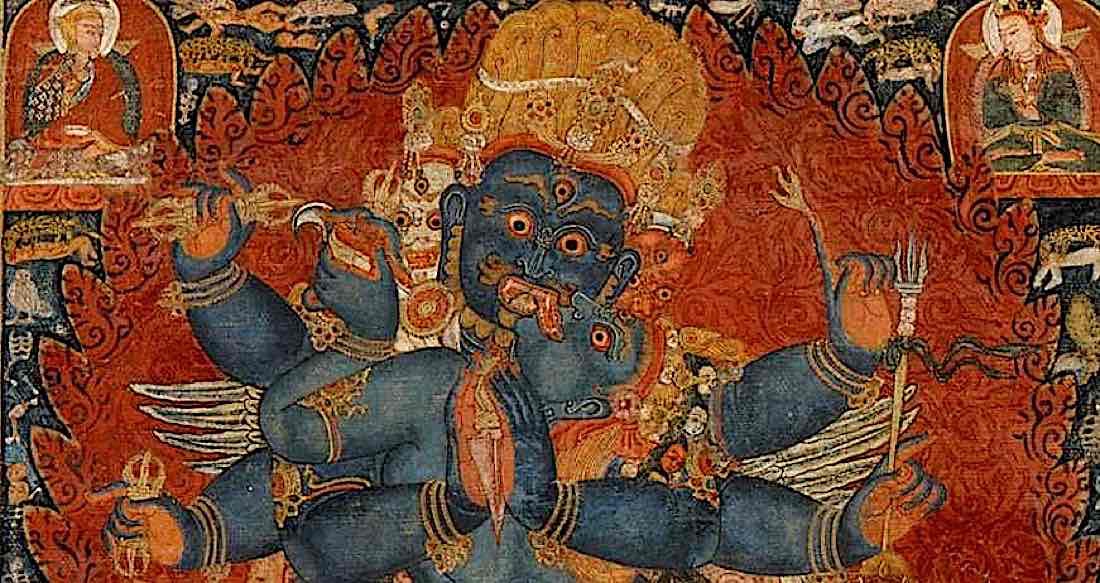
NOTES
[1] Sir Monier Monier-Williams; Ernst Leumann; Carl Cappeller (2002). A Sanskrit-English Dictionary: Etymologically and Philologically Arranged with Special Reference to Cognate Indo-European Languages. Motilal Banarsidass (Reprint of Oxford University Press 1899 version). p. 436. ISBN 978-81-208-3105-6.
[2] Tribute to the Ancient Yogi Shiva, The Yogic Way of Life
[3] About Pierre Bernard “Oom the Magnificent”
[4] The Life and Works of Theos Bernard
[5] Buddhist Texts Through the Ages, by Edward Conze, Introduction: Philosophical Library/Open Road
Release Date: December 2, 2014
Imprint: Philosophical Library/Open Road
ISBN: 9781497675834
Language: English
[6] There and Back Again: The Unity of Samsara and Nirvana in Tantric and Zen Buddhism by Sasha Manu
[7] Sex and Buddhism, Robin Kornman
[8] “Introduction to Tantra: A Vision of Totality” [1987], p. 37, Lama Yeshe
[9] Rob Preece. The Psychology of Buddhist Tantra (Kindle Locations 79-81). Kindle Edition.
Latest Features
Please support the "Spread the Dharma" mission as one of our heroic Dharma Supporting Members, or with a one-time donation.
Please Help Support the “Spread the Dharma” Mission!

Be a part of the noble mission as a supporting member or a patron, or a volunteer contributor of content.
The power of Dharma to help sentient beings, in part, lies in ensuring access to Buddha’s precious Dharma — the mission of Buddha Weekly. We can’t do it without you!
A non-profit association since 2007, Buddha Weekly published many feature articles, videos, and, podcasts. Please consider supporting the mission to preserve and “Spread the Dharma." Your support as either a patron or a supporting member helps defray the high costs of producing quality Dharma content. Thank you! Learn more here, or become one of our super karma heroes on Patreon.
Lee Kane
Author | Buddha Weekly
Lee Kane is the editor of Buddha Weekly, since 2007. His main focuses as a writer are mindfulness techniques, meditation, Dharma and Sutra commentaries, Buddhist practices, international perspectives and traditions, Vajrayana, Mahayana, Zen. He also covers various events.
Lee also contributes as a writer to various other online magazines and blogs.



